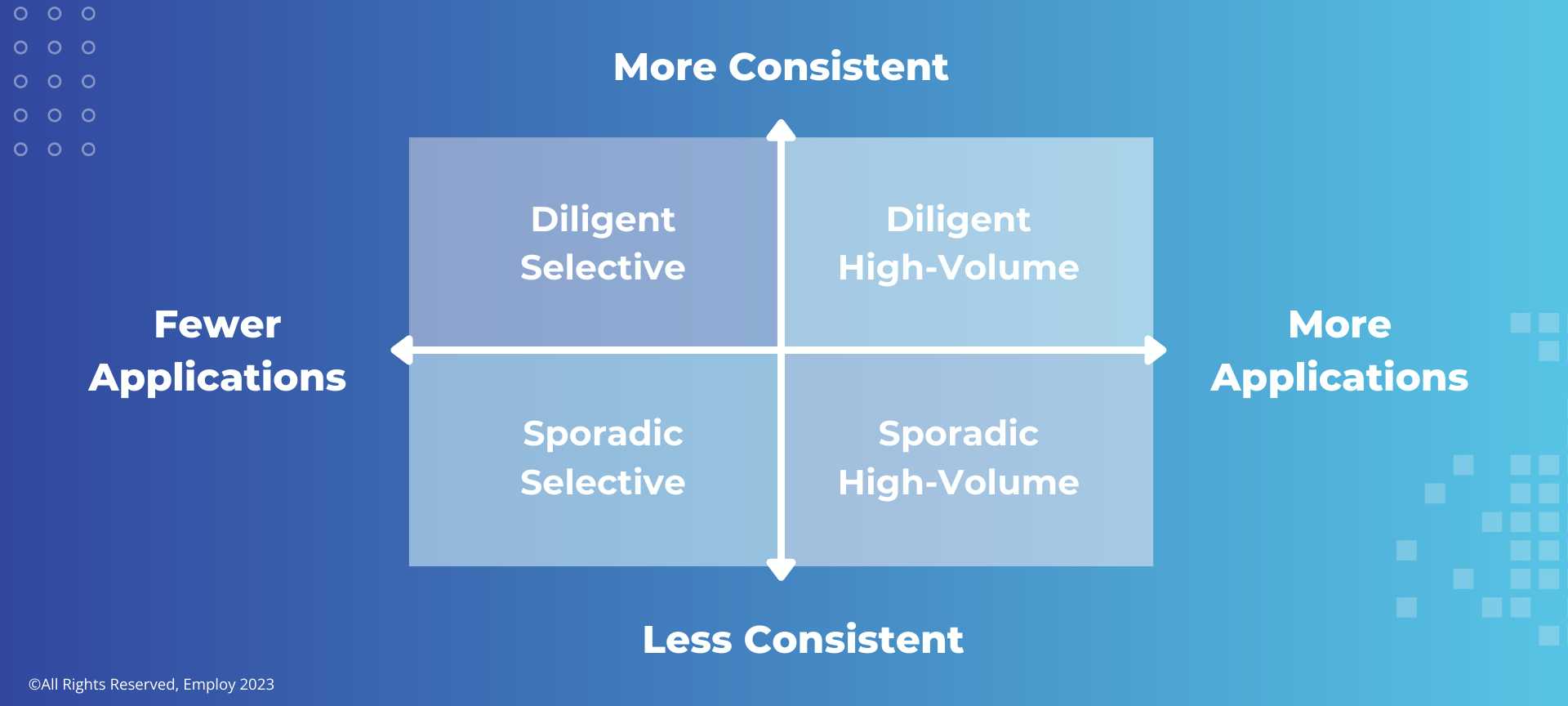In today’s competitive market, finding the best candidate for the role is no easy feat. While we generally find more available talent in the pool, ensuring a high-quality candidate with a strong fit for the position compounds the complexity of recruiting. Recruiters have to embark on candidate conversations while unsure what’s driving each candidate to seek a new position and how that motivation affects their outlook during the search process.
Defining a persona framework can help recruiters get to the heart of what’s driving each applicant, what they’re looking for in a new opportunity, and which tactics will keep them the most engaged throughout the process.
Recent data from Employ shows that today’s jobseekers can be divided into four groups based on a combination of two key traits:
- How consistently they search.
- The number of positions to which they apply.
These two traits interact in the following way to create four primary persona categories:


When recruiting teams understand these four personas—and how to spot them—they are more prepared to understand candidates and empowered to customize the candidate experience in a way that resonates with each person they speak with. This often results in better placements, shorter time-to-fill, and more successful hires.
All About Diligent/High-Volume Applicants
Diligent/High-Volume applicants make up about 10% of the current market, and they are driven by economic and employment market conditions. These applicants are primarily triggered by job posting alerts and will apply to a wide range of positions with various responsibilities and job functions.
Traits
Diligent/High-Volume job seekers tend to be optimistic, believing it will take less than a month for them to find a job, and they apply for jobs with large salary ranges. Additionally, this type of job seeker tends to gravitate toward roles at companies with strong leadership, room to advance, and resources for career development.
Approach
Diligent/High-Volume job seekers will use social media and subscribe to job advertisements and will likely mention their research during the interview process. As frequent resume updaters, these candidates tend to begin their job search within their current organizations and will apply for jobs at other companies even if there isn’t an opening.
Engagement tactics
These workers tend to appreciate simple, straightforward interview processes. These candidates are likely to abandon opportunities if they find them too time-consuming, so streamlining the interview and scheduling process is likely to impress.
All About Sporadic/High-Volume Applicants
About 25% of applicants in the current labor market are considered Sporadic/High-Volume applicants. These are the people who turn to LinkedIn or other job boards after a particularly bad or frustrating day at their current position.
Traits
These applicants are usually satisfied in their current roles. They may be seeking out organizations that tout career advancement opportunities. As a result, they tend to apply to multiple jobs that they have no intention of accepting. They tend to be just beginning their career, have taken a new job in the past year, and apply for jobs with large salary ranges. Like their Diligent/High-Volume counterparts, these job seekers frequently update their resumes, and keep an eye on their current companies’ financial positions.
Approach
Recruiters can identify Sporadic/High-Volume job seekers by their application method. They regularly search job boards and appreciate easy scheduling. If the interview went well, an offer was made, but the job seeker sends an impersonal response or even goes dark, a Sporadic/High-Volume job seeker may have crossed your path.
Engagement tactics
To capture these applicants, stay away from hiring channels that require registration as a part of the hiring process. They’re likely to abandon applications that require any registration elements. Even though they are likely to be satisfied at their current role, recruiters that think a Sporadic/High-Volume applicant is a perfect fit may get their attention with an incredibly compelling offer but should be ready to negotiate and to respond to their current employer’s counter.
All About Diligent/Selective Applicants
Diligent/Selective job seekers are triggered by burnout, and about 40% of applicants fall into this category. Since burnout is a trigger, they are hesitant to apply for jobs they feel they are unlikely to get and prefer efficient processes. They are serious about their search and conduct it over a long timeline.
Traits
Diligent/Selective job seekers are not interested in applying for positions with wide salary ranges. They know what they are looking for and stick to those parameters. They are less inclined to search for new opportunities within their current organization and motivated by specific roles that excite them.
Preferences
Diligent/Selective job seekers tend to stick to a single application method: the company’s website. Additionally, they are highly prone to abandonment and prefer short and efficient recruitment processes.
Engagement tactics
These applicants tend to be targeting companies or roles that speak to them, so defining a company mission, vision, and value set is incredibly important when encountering Diligent/Selective job seekers. Make highlighting these aspects of the company a priority early in the interview process and try your best to keep initial applications brief, yet comprehensive.
All About Sporadic/Selective Applicants
Sporadic/Selective job seekers are triggered by boredom in their current situation and make up about 25% of today’s applicants. Like their Diligent/Selective counterparts, they are unlikely to submit applications to employers that they deem unlikely to hire them.
Traits
These applicants tend to be later in their career. They rarely apply for open roles at their current company, do not apply for jobs with large salary ranges, submit few applications for new roles, and do not use social media to find open roles.
Preferences
Sporadic/Selective job seekers’ applications tend to favor brevity and their resumes tend to possess stale skills as they have not likely invested time in their own learning and development. Since they’re motivated primarily by boredom and exploration, they’re also hesitant to spend time on additional application materials, preferring to let their experience speak for itself.
Engagement tactics
To engage these applicants, create highly personalized, effortless recruitment experiences. They’re applying to see what’s available to them as they currently are, so if you think a Sporadic/Selective applicant is the perfect fit, it’s best to keep extraneous tasks to a minimum. They also strongly believe that the modern hiring process is excessive, so it’s critical that recruiters communicate decisions or next steps and their reasoning throughout the process.
Setting up for success
In today’s market, recruiters need to go the extra mile to ensure success along each step of the recruiting process. Using the four personas as a baseline can help recruiters begin the process of tailoring their hiring strategies to a given candidate’s needs.
Finding talent is tough, and recruiters need to arm themselves with tools to find quality candidates for open roles. Though each candidate is unique, keeping the four personas in mind throughout the process helps remind recruiters that hiring is not a one-size-fits-all endeavor. Understanding the four job-seeking personas and their associated triggers helps recruiters provide high-quality candidate experiences and fill skill gaps more quickly and successfully.
By Corey Berkey, SVP of People, Employ Inc.





